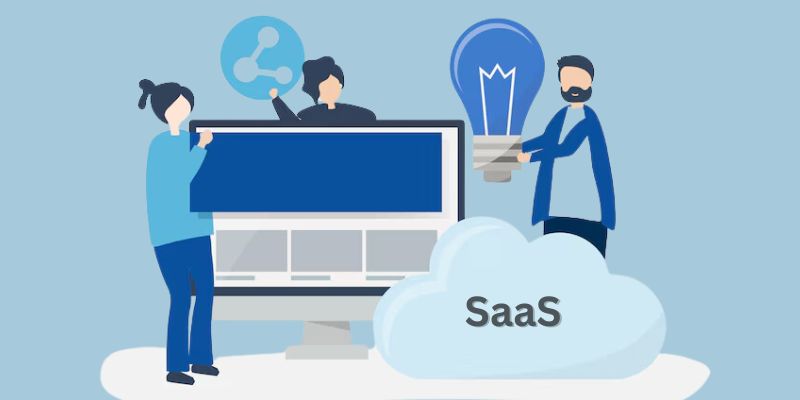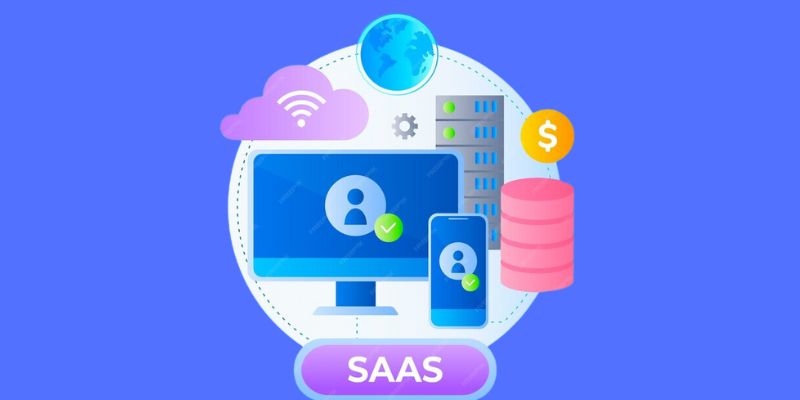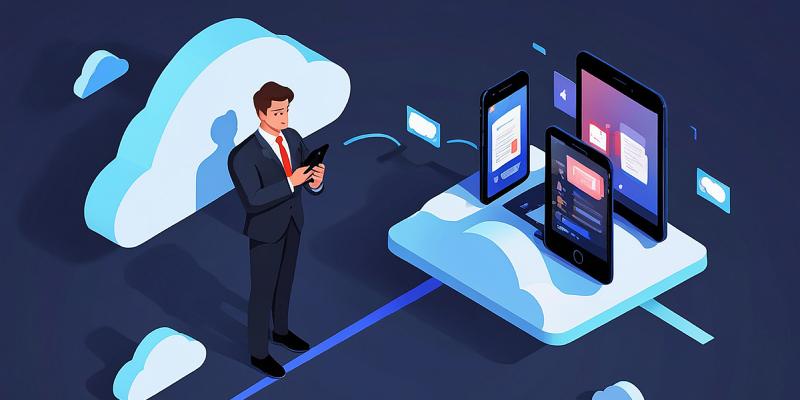In today's digital landscape, cloud-based Software-as-a-Service (SaaS) applications have significantly succeeded due to their scalability, flexibility, and cost-effectiveness. The development of a successful SaaS application demands careful preparation and execution. Cloud-based SaaS applications development are an exciting option for companies and users of traditional software in various industries because they offer an extremely convenient subscription-based system. They cut down on how much businesses and entrepreneurs were required to funnel into product licensing. They also took a lot of security, maintenance, and support issues out of the equation and put them entirely on the SaaS company's obligation.
The SaaS software model is growing in immense popularity thanks to its technical capabilities and ability to fulfill users' needs in today's high-tech world. That's exactly why Custom SaaS Development is a win-win for both parties to the equation—vendors offer highly sought-after deals. At the same time, users benefit from simple and secure software in which they pay only for the features they get, nothing more, nothing less.
This post will outline the most essential actions to help you develop an online SaaS application that delivers outstanding value for your clients.
Also Read: An Ultimate Guide to Developing Cloud Based SaaS Apps
What Is a Cloud-based SaaS Application?
Software as a Service (SaaS) is a cloud-based means of delivering software over the Internet. Software based on the SaaS application development business model hosted in the cloud can be described as a cloud-based SaaS app. Users can avail themselves of an application with all the needed functionality located on the cloud. The cloud doesn't require any physical space and doesn't have to manage and maintain the operation of the hardware software. SaaS applications can be accessed via desktop and mobile applications and web-based interfaces.
Since it's cloud-based because it is cloud-based, the SaaS app allows users to access their data via any device or web browser with any internet connection. A subscription model frees users from installing it on their device and then installing it. A cloud computing service maintains its infrastructure, performance parameters, security, and accessibility. The best SaaS developers offer all-inclusive solutions, transforming your concept into a robust, expandable SaaS application.
Must Read: Software Development vs SaaS Development: Core Differences
Benefits Of Cloud-Based SaaS Applications

Based on these figures, The SaaS application development model makes both consumption and development more efficient, affordable, and profitable in the long run. Cloud computing presents a variety of new possibilities for companies across various fields, and it's wise to explore these opportunities.
We will discuss the numerous benefits of developing a cloud-based SaaS application in 2024 by the top SaaS developer. These are cutting-edge benefits to be gained with SaaS application development.
Higher Performance
When you use cloud-based SaaS application development, everything runs on a central server. Therefore, the communication between the users and the application always continues smoothly. There are no bottlenecks, response time delays, or issues with data access, as in conventional software development. Furthermore, the software's risk of failure is completely zero.
Development Flexibility
Utilizing cloud-based SaaS software, tweaking or changing your system's configuration based on your business requirements becomes easier. SaaS software automatically updates your users to ensure they can access the most current capabilities, updates, and security updates. Furthermore, automated updates ensure the SaaS application development is constantly up-to-date with new hardware and software, improving effectiveness.
Cost Efficiency
The main difference between SaaS application development services and other traditional software products is that the former operates from an established cloud environment. This means that you do not have to buy expensive equipment or hire additional personnel to handle post-development maintenance and customer service operations. Access to full functionality, anytime and anywhere, without any hardware expenses. Because SaaS applications use subscriptions, your customers will only be charged for what they want, and you can increase or eliminate users at any time. This could result in significant cost savings for your company.
Furthermore, SaaS applications offer win-win pricing for both users and developers. Most SaaS developers have multiple pricing plans, meaning you can begin at a low level and increase the price as your company grows. However, the most important thing is to precisely match the pricing plan's features to suit users' needs.
Regular Income Stream
This benefit is derived from the one mentioned above: The SaaS system allows you to transform your service into an income stream that is stable through subscriptions. Additionally, sales and profits are more reliable since users sign up monthly or pay annually in one payment. You can also make money from advertising in the app.
From this perspective, look at the potential profits you can earn when you create a cloud-based SaaS application and make it monetized correctly. Cloud-based SaaS applications could help gain customers and develop an impressive client base. But, with well-organized management and the development of new products, you'll become a massive audience of loyal customers, which is the main ingredient of any company's growth.
Read About: Which are The Top SaaS Startup Ideas for Industries Beyond 2024?
Steps To Build a Cloud-Based SaaS Application USA 2024
Creating a SaaS product has been streamlined compared to traditional software development, yet many similarities remain. To provide an unrivaled experience and sturdy application, you will need an established cloud provider with the fundamental capabilities to create and support the new SaaS design.
Your first item to check off your list is finding a reliable cloud provider that is savvy and reliable for hosting the SaaS application development platform. Once you have found a well-established company or group consisting of SaaS developers, there are a variety of phases to manage. Cloud-based SaaS application development differs based on the app's type and budget. It also depends on the features that are required.
Idea Validation
The first step to making any product digital is to test the idea's viability. SaaS applications' success relies heavily on using the appropriate technology stack, assessing the intended market, and targeting the business needs, audience, and needs of end users. The SaaS Development Company is accountable for technical issues. But, as an owner of your own business, it is your responsibility to develop your own SaaS concept and conduct a thorough market analysis.
Using experienced business analysts' assistance, study your competition, analyze their products and services, and identify the latest trends in your industry. If you can get a clear concept of the SaaS product, put your efforts towards project estimation. It is crucial to follow these steps to guarantee proper validation.
Project Discovery
This is the stage where you must turn your SaaS application idea into a clear plan with your technology partner. Together, you will create the desired product. This phase includes conducting business analysis and creating documents for further SaaS application development stages based on your collected data. The discovery process is an essential part of the development process since it involves major choices, including selecting the cloud service provider and subscription model and describing the risk assessment process specifications.
These features are customized and function, as well as estimations of costs. Be aware of the cost associated with cloud service plans and any other costs when creating the budget. Furthermore, other details like development methods and cloud computing platforms are considered. Planning is essential in outsourcing software development because it can help reduce unnecessary costs.
UI/UX Architecture
The primary task for the chosen software vendor is to design a user-focused architectural design based on the study, the business analysis, and the tools available. It involves planning, designing, making, and then integrating the user interface as well as user experiences - including visuals (colors buttons, colors banners, system information, etc.) as well as.) and the ways elements react to user interactions are worked through in this phase.
The result could be an MVP that serves best as a tool for "trying out the market environment." The minimum viable product version of your complete solution is an excellent way to determine how well the UI/UX works with real customers.
Technology Stack Selection And Engineering
After creating the app, it's time to select the appropriate tools and methods for front-end, server-side, and database development. In this phase, an MVP (minimum feasible product) is created based on the SaaS application. MVP is the app's most basic version with the most basic functions, and it is enough to be launched and offered to first users. The app allows creators to evaluate the performance and functionality of the app quickly, identify weaknesses, and then fix them before releasing additional features.
The team of developers selects the technology appropriate for the task. The stack of technology used in developing a cloud-based SaaS application comprises a mixture of back-end and front-end technology. This is a highly efficient SaaS-oriented technology stack with standard tools for creating SaaS applications.
-
CDN - Amazon Web Services
An online content delivery system (CDN) is necessary to bridge the server and device. CDNs can provide a smooth user experience by sending content to users' devices directly from the server closest to them. AWS is one of the most well-known and tested CDN frameworks available.
-
Front-End: HTML/CSS And JavaScript framework
Creating and improving user-focused components and features is always a distinct stage and a key element in the final product's user experience. The classic combination of HTML/CSS with the JavaScript framework, such as React, Angular, or Vue.js, can't be underestimated when it comes to this.
-
Server-Side - Python, JavaScript, Ruby or PHP
A database and server are the most critical components of a SaaS solution; however, they need to operate from a place. The ideal server-side platform can be developed using one of the most popular languages: Python, JavaScript, Ruby, or PHP. In addition, a compatible framework is required for each framework, e.g., Django, Node.js, Ruby on Rails, and Laravel. The appropriate framework and language choice will be based on the project's requirements, specifics, and the work ethic of the team hired to develop.
-
Database - MySQL Or PostgreSQL
The database must be used to back up data storage. It has to be a relational database, which narrows your choices down to two options: MySQL (a traditional relationship DB) and PostgreSQL (an object-relational DB for performing more complicated processes that require more complicated kinds of data).
-
Server - Apache Or Nginx
Last but certainly not least, depending on the objectives and development methods, the software company you choose to work with could use Apache (multi-threaded server architecture) or Nginx (single-threaded server architecture) for the primary server.
Following this, the design process gets underway. DevOps engineers participate during this step in setting up continuous integration and delivery (CI/CD) tools and automated tools and increasing the efficiency of managing configurations. Most importantly, the type of cloud-based solution and the cloud provider are selected during this stage.
Testing
Testing typically occurs throughout the entire developing process, with testing being the final step before the deployment process. The SaaS test of the application is concerned with ensuring that the app meets users' requirements and runs smoothly. QA engineers conduct different quality assurance tests, such as Usability testing, performance testing, and security tests, to identify defects and bugs.
Certain SaaS developers like to include both manual and automated testing in their QA process to rectify mistakes and cover the SaaS solution completely. In addition, the QA team constantly monitors the application after its launch for quality assurance and performance.
Deployment
The deployment of a cloud-based SaaS application is the procedure for making the application available to the end user via the Internet. When your app has been developed and tested, it's ready to go live. Cloud-based SaaS expert developers will run your app using a cloud-based platform. Users can access your app anywhere on the Internet. Implementing a SaaS solution may be complicated. Working with skilled SaaS experts for faster and more flexible deployment is essential for avoiding pitfalls.
Maintenance And Support
The last and crucial step in creating the cloud-based SaaS application is having the development team manage it, track its performance, and improve its performance following the initial launch. This allows you to satisfy customers' needs and develop more features when necessary. In the present, you'll need to enhance the user interface and solve UX problems, monitor security issues, and make sure that the application is up and running to grow rapidly.
Must Read: Cost Estimation For SaaS, Cloud, and On-Premise Development Solutions
Costs Of Cloud-Based SaaS App Development

Many variables affect the price of creating a SaaS product. When you first start out by creating an MVP, the typical cost range is between $15,000 and $50,000. If you want to expand to a fully-fledged solution, using professionals who have the right equipment could result in a cost of twice that, between $30,000 and $100,000. Outsourcing can reduce the price of the process without degrading the quality.
The top factors that affect the price of SaaS application are:
Business logic
It covers the procedures involved in the general operation that comprise the overall functioning of the SaaS application. Also, it outlines its purpose and the desired outcome that meets your target audience's requirements. In the end, it's the foundation from which you can decide on the features and functions of your app.
Application Architecture
The structure of SaaS is how it is arranged, and the interrelations between various organizations are based on technological and business requirements. The more intricate your concept is, the more excellent effort engineers must put into building integration, increasing the cost of SaaS services.
Scope SaaS product
The scope of your project is among the primary things you need to determine. The next step is to choose whether the SaaS application is a tool or a platform because the functions and features will be altered. In addition, the time it takes to develop platforms or tools can differ, affecting the cost of SaaS implementation.
While the tools are restricted in scope and can manage crucial tasks, Buffer has an expanded scope. Performing the function correctly can serve multiple functions. Therefore, even though Google Workforce is an example of a SaaS tool, Buffer is an apt model. According to the application's scope, the capabilities vary, as do the work, time, and price.
Features
To determine the price of SaaS services, you must identify the factors in question. The kind of feature the product has affects the length and expense of a SaaS product. In the initial stages of an initiative, you will focus on critical features when creating an MVP. After receiving customer acceptance, you can build a complete product. In both instances, costs vary depending on the feature's quantity, types, and degree of complexity.
API Integration
If you're a developer, you likely have to determine whether to design the entire back-end entirely from scratch to allow an extensive level of personalization or use API integrations provided by third parties. It is possible to choose APIs that offer essential functions like payments, subscriptions, or log-in. This can allow you to reduce expenses.
API integration comprises API-based methods that can perform the CRUD operation (Create, Read, Create, and Update). These operations are the principal methods of using and managing data via RESTful APIs. The seamless API integration allows organizations to use existing functions with different applications. In addition, APIs can aid in sharing data and automatize the system.
However, developers need to adhere to best practices, such as reviewing documents, selecting reliable APIs, analyzing security weaknesses, and addressing scalability issues. Each of these steps can be considered a mini-project requiring knowledge, expertise, and precision. That's why it takes a significant amount of time and effort to make sure it's perfect, which will affect the total cost.
Platform
As with other software, choosing which platform you want to use for SaaS is possible. For example, a B2B business must create web-based applications since most clients use computers or laptops. In contrast, B2C companies are more inclined to choose mobile-friendly applications since they anticipate users can access the application via mobile phones. Even though the content stays identical primarily, the UI/UX is modified and can impact the cost of the SaaS product.
Post-Release Cost
There is a belief that, after the end of SaaS software development, it's over with the tale, and no more work will be done. This isn't true. Following the initial development, there are costs post-release related to improvements in hosting, maintenance services, databases, servers, and even integrations.
Read Also: How Data-Driven SaaS is Transforming industries
SaaS Application Revenue Opportunities 2024
The SaaS model simplifies monetization possibilities such as the ones below, thanks to the fundamental advantage of offering software as a single-time sale rather than a continuous service. Do you want to learn how to make SaaS software earn a steady income? Use and combine some of the revenue generation models.
Subscriptions
SaaS is a great way to generate annual profits via subscriptions. It brings a variety of benefits for businesses. With lower upfront costs, customers are more likely to consider a long-term subscription that provides continuous installments. To more effectively encourage and entice users to sign up by offering a trial time, free trials could be provided, and the user could be urged to sign up when the trial is over.
Pay Only For What You See
Users can be charged for the quantity of space they need, the extent of their functionality, and the number of connected user profiles. That's why complete price transparency is a significant motivating factor—customers love transparent pricing without hidden charges or costs. Similar principles apply to subscriptions, as different tiers with various levels of functionality are available (e.g., restricted/partially limited/unlimited).
Freemium
The essential functions are free to use while offering premium capabilities for purchase, which is a popular method of monetizing. We've already discussed that subscriptions can be divided into several tiers. In this case, for instance, you could offer a basic membership at no cost, provide an option to eliminate ads at the price of a paid subscription or allow a variety of premium options and additional capabilities with the premium version of your subscription.
In-App Advertising
Old-fashioned ads will stay, and they should not be included in regular advertisements, banners, hyperlinks, or discounts. Advertising lets you earn from click-through rates in addition to utilizing combination strategies. Earn money on ads that click through from simple subscriptions and a separate piece of revenue from the payment for subscriptions that have removed advertisements.
Also Read: SaaS Software Development Best Practices: 2024
Challenges Of Building a Cloud-based SaaS Product
The process of creating SaaS software has some challenges and also potential pitfalls. One of the most effective ways to conquer them is to remain up-to-date and prepared for possible problems.
Attaining High-Level Security
Although the most up-to-date cloud security methods are robust, cloud-hosted information is susceptible to unauthorized disclosure leakage and security intrusion. This issue hinders the adoption of the SaaS model among the vast majority of users and software companies. The only way to deal with the security risks that could arise is to improve the system's overall security in all methods. Therefore, ensure you have an additional security budget and get more in-depth information on the subject.
High Availability
It isn't easy to implement a zero-downtime approach when using SaaS solutions, i.e., you must ensure that your service is always operating. This is partly due to the stability of your internet connection requirements and various Internet connection-related issues. However, the primary reason for this is the challenge of not causing downtime when updating software. To eliminate this problem, it is recommended to either install updates only during inactive times of the day (research the subject independently). Keep the backup environment in place in which you can apply updates before switching on the primary usage.
Locating Trustworthy Specialists
It is essential to have a dedicated staff of skilled specialists who can tackle your task from head to toe for a high-quality end product. An authentically reliable service offers a wide range of services, provides transparency throughout all project steps, and enthusiastically demonstrates how to construct a SaaS application with the most efficient and effective method.
Updates
One of the most common SaaS problems is the inability of your system to be available for updating or the release of the latest version. This can be overcome through careful scheduling and informing your clients about the scheduled downtime time frame. Alternatively, the SaaS Development Agency may use the blue-green deployment method, ensuring the system is accessible while updates are performed.
Final Thoughts
Developing an online SaaS app is a complex procedure requiring a particular strategy and distinct expertise. Successful SaaS application development of apps is driven by experience and an appropriately segmented approach. The SaaS application development model is prevalent due to its immense benefits for entrepreneurs and their customers. If you entrust your application development work to a particular company, ensure they're knowledgeable and utilize the latest technology platform. Additionally, it's essential that you have the support of SaaS specialists in development who will provide the proper running of the app. Also help in identifying opportunities for improvements, and stay current with rapidly changing marketplace trends.
Contact us today to establish a world-class team of developers to work on your cloud-based SaaS application development plan! Let's work together to make your SaaS application development business plan a reality!













Share this blog